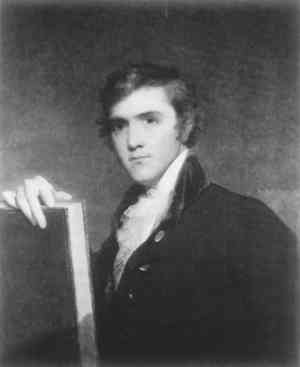19TH-CENTURY PORTRAITS ON SCORED PANELS IN THE CLEVELAND MUSEUM OF ARTCHRISTINA CURRIE
4 APPLICATION OF TEXTURE: INTO PANEL OR GROUND?Scoring patterns were either applied directly to the panel support or added after the ground layer was applied. To distinguish between the two methods, the paintings were examined with ordinary light, under magnification, and with x-radiography. In most cases, it was then possible to deduce the source of the pattern (table 1). In most paintings, the visibility of the wood grain as white markings in the x-radiograph indicates a significant lead content in the ground layer. By the same principle, deliberate incisions made into the panel itself prior to priming become prominent in the x-radiograph as sharp white lines, such as the diagonally scored lines in Samuel Barber Clark (see fig. 2) and Portrait of a Man (see fig. 5). These white lines appear to have more contrast and are more clearly defined in the x-radiograph when the overlying paint layers are dark and do not contain significant proportions of lead white. If the incised lines appear dark and soft-edged in an x-radiograph where the wood grain is visible as white markings and the ground as whitish brush In some paintings, areas of paint and ground loss provide evidence of scoring before groundlayer application. In Thomas Hart Benton, the top and bottom 1.1 cm of the panel were never primed (see figs. 6, 7). The paint layer, however, extends to the edges of the panel. With x-radiography and the naked eye, the vertical scoring pattern is clearly visible across the full length of the support. The incised lines appear much sharper on the 1.1 cm of the top and bottom edges where they have not been softened by an overlying lead white–based ground layer. Ambiguities in interpretation do occur, especially when the scoring lines are of a similar width to the spaces between them. An example is Mrs. James Stuart. In the x-radiograph, the visible wood grain indicates a lead white–based ground (this x-radiograph is not illustrated, because a supporting cradle confuses the image). In certain places, the ground layer can be distinguished as broadly applied strokes. These strokes are cut through by dark lines, indicating that the scoring process occurred after ground application. Another confusing x-radiograph is that of Independent Beggar (see fig. 3). In this instance, microscopic examination revealed the presence of the wood support in some abraded high points of the scoring pattern, suggesting that the scoring pattern was applied to the panel directly before priming.
Benjamin Rouse (see fig. 4) presents a different problem. There is no clearly defined wood grain in the x-radiograph. Close examination of the painting's edges reveals abraded areas where the scoring is etched into the panel support. However, in another area of the edge, the exposed ground layer is physically separated by scoring lines as if the scoring had been applied after the ground. The x-radiograph shows the scoring pattern as thin, sharp white lines. On balance, it seems likely that the scoring was Of the 100 or more panel paintings by Gilbert Stuart that the author has seen, only a handful are not scored, including Henry Knox (ca. 1805, Museum of Fine Arts, Boston). Stuart's scored panels exhibit a range of linear pattern types that vary in direction, angle, and fineness of line. More often, his lines run in one diagonal or the other, although in some cases the panel has been scored in both diagonals, as in John Adams (ca. 1825, National Gallery of Art). Both Stuart's Egbert Benson (ca. 1820, New-York Historical Society) and Jarvis's copy of it (ca. 1820, New-York Historical Society) exhibit a light diagonal scoring pattern. However, in the Stuart original the incised lines run from upper right to lower left, while in the copy they run from upper left to lower right with occasional lines in the other diagonal. Past writers on Stuart asserted that he started to “twill” wood panels following Jefferson's embargo on shipping in 1807, when he experienced problems importing English twill canvas. Goldberg challenged this myth and gave many examples of scored panels after import restrictions were lifted (Goldberg 1993). This author would like to strengthen her case by supplying an example of a textured panel by Stuart securely dated seven years before 18071. Stuart's Horace Binney (1800, National Gallery of Art) is scored evenly in a diagonal direction from upper right to lower left (fig. 9). The x-radiograph, not sufficiently clear for reproduction here, shows groups of fine, soft-edged dark scoring lines indicating that the scoring was carried out into the ground layer rather than directly into the panel. These x-radiographic line characteristics are very similar to those in the x-radiograph of Jarvis's Thomas Abthorpe Cooper (see fig. 1). Stuart's preference for working on textured panels therefore evolved separately from the shortages of English twill canvases during the embargo. Stuart probably initiated the fashion for texturing panels around the turn of the century, but there are countless panel paintings in historical collections that must be examined first before drawing conclusions.
In European panel painting, the author has seen no examples of panels with incised linear patterns, the goal being to present as smooth a surface as possible. However, small random patches of scoring are sometimes noted in Flemish panel painting, such as an approximately 2 cm2 area of diagonal scoring in an anonymous Flemish panel painting, the 10th panel in a series of 16 illustrating the life and martyrdom of St. Victor (ca. 1510–20, Museum van Busleyden, Mechelen). These patches are certainly not intentional. They are more likely left behind after the rough leveling of the ground layer before it was smoothed down with a plant called pr�le (Mare's tail). Intentional texturing |
